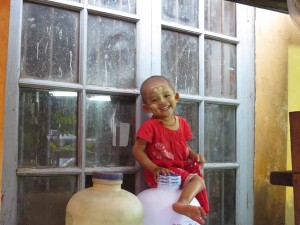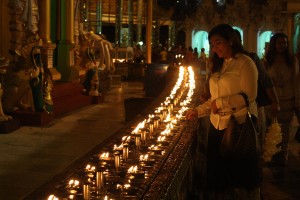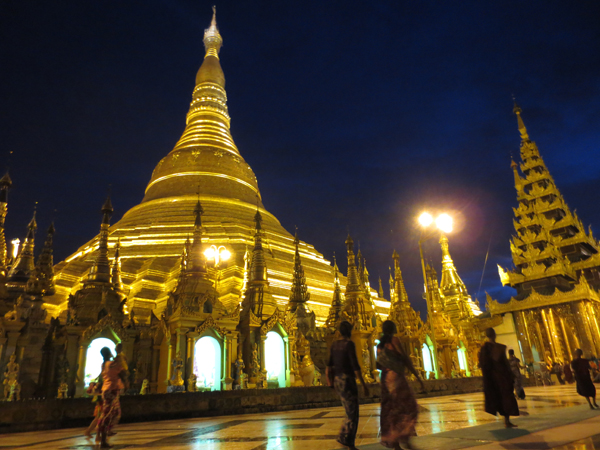Yangon
I had somewhat of a rough start in Yangon. First of all, it was raining like crazy. Second, I did know that Myanmar was a developing country, but I did not quite realize the lack of basic infrastructure I would have to 
deal with. Part of Yangon reminded me of my trip to India 10 years ago. And when I mean basic infrastructure, I mean things like a functional sidewalk.
So I got to Yangon right after having hurt my shoulder by doing some kind of wrong movement. Now it was raining non-stop and the sidewalk had huge holes, sometimes transitioning into muddy puddles that were surprisingly deep. So often I had to jump from one portion of the discontinued sidewalk to the other one. And more than once did I slip in this endeavor and hit the ground, each time further hurting my shoulder. If I was unlucky, I even fell into the mud puddle and ended up with mud up to my knees. Once, one of the wooden planks making out the train over-crossing even collapsed under my feet. This could have ended badly if I hadn’t been able to hold on to the railing as soon as it happened. The sidewalk of Yangon definitely felt like an unpleasant obstacle course, required continuous focus and was probably the biggest “threat/danger” of the city.
 Yet, the people were so incredibly nice in this town that I did want to like it and I did like it overall. Yangon has character and I think I would have had a very different experience if it hadn’t rained that much. Somehow, Myanmar in general has a disproportionate number of people that really go out of their way to help and welcome foreigners. I have had so many people stop on the walkway just to welcome me to their country. As soon as I take out a map or look a little bit lost, I will immediately be surrounded by several Burmese trying to help me even though they can’t read our alphabet and thus don’t understand the map that I am looking at. It also happened to me more than once that I asked a taxi driver for directions. I always assumed that the taxi driver would either tell me that my destination is just around the corner, or instead offer to take me there. Nope… They would persistently go through great trouble explaining how to get there, sometimes even drive next to me to make sure I walk the right way. If I asked how far it would be, they never seemed to understand the question. So more than once I ended up walking quite some distances when I would have been happy to pay the $2-3 taxi fare. Unlike so many other countries I visited, it really seemed to me that Burmese were genuinely curious about me and wanting to help me, without necessarily being after my money. Yangon itself seems to be a mixture of so many different cultures and religions. Although Myanmar is primarily Buddhist, I have seen so many mosques, Hindu temples, christian cathedrals, and Chinese temples in Yangon. All of these different cultures/neighborhoods just seem to blend into one another.
Yet, the people were so incredibly nice in this town that I did want to like it and I did like it overall. Yangon has character and I think I would have had a very different experience if it hadn’t rained that much. Somehow, Myanmar in general has a disproportionate number of people that really go out of their way to help and welcome foreigners. I have had so many people stop on the walkway just to welcome me to their country. As soon as I take out a map or look a little bit lost, I will immediately be surrounded by several Burmese trying to help me even though they can’t read our alphabet and thus don’t understand the map that I am looking at. It also happened to me more than once that I asked a taxi driver for directions. I always assumed that the taxi driver would either tell me that my destination is just around the corner, or instead offer to take me there. Nope… They would persistently go through great trouble explaining how to get there, sometimes even drive next to me to make sure I walk the right way. If I asked how far it would be, they never seemed to understand the question. So more than once I ended up walking quite some distances when I would have been happy to pay the $2-3 taxi fare. Unlike so many other countries I visited, it really seemed to me that Burmese were genuinely curious about me and wanting to help me, without necessarily being after my money. Yangon itself seems to be a mixture of so many different cultures and religions. Although Myanmar is primarily Buddhist, I have seen so many mosques, Hindu temples, christian cathedrals, and Chinese temples in Yangon. All of these different cultures/neighborhoods just seem to blend into one another.
In general, Yangon seems to be a city of contrasts. You would have a shabby little road that I would feel slightly uncomfortable walking down next to a brand new Parkson shopping center where a janitor would wash after each of my steps because of the mud left by my shoes. Similarly, you would also have gigantic structures of precious stones (usually to mark a Buddhist pilgrimage site) within a completely run down neighborhood with facades covered by humidity stains, and roads barely holding together.
 Undoubtedly, the main attraction of Yangon are these numerous Buddhist pagodas. People in this city seem to be completely obsessed with gold and gigantic statues of Buddha. The most impressive of these structures is the Shwedagon Paya, a 98 meter high pagoda made out of gold and further embellished with other jewels. Inside of this pagoda are a few strands of Buddha’s hair. The structure is impressive by its grandeur, but also feels truly magical by the atmosphere of devotion around it. There are 8 small shrines around it, one for each weekday except Wednesday which has two shrines. So people who are born on a Monday, pray and make offerings at the Monday shrine. The “praying” typically involves lighting candles, washing a Buddha statue, leaving flowers for Buddha and possibly even making food offerings. At sundown, there are literally hundreds of Burmese gathering at the pagoda and praying next to their respective weekday. What a beautiful sight!
Undoubtedly, the main attraction of Yangon are these numerous Buddhist pagodas. People in this city seem to be completely obsessed with gold and gigantic statues of Buddha. The most impressive of these structures is the Shwedagon Paya, a 98 meter high pagoda made out of gold and further embellished with other jewels. Inside of this pagoda are a few strands of Buddha’s hair. The structure is impressive by its grandeur, but also feels truly magical by the atmosphere of devotion around it. There are 8 small shrines around it, one for each weekday except Wednesday which has two shrines. So people who are born on a Monday, pray and make offerings at the Monday shrine. The “praying” typically involves lighting candles, washing a Buddha statue, leaving flowers for Buddha and possibly even making food offerings. At sundown, there are literally hundreds of Burmese gathering at the pagoda and praying next to their respective weekday. What a beautiful sight!
 Besides the Shwedagon Paya, there are many other pagodas in Yangon, two of which also contain some of Buddha’s hair. In addition, there are also several gigantic statues of Buddha in sitting and lying poses. Of course these statues are decorated with various precious stones and interestingly, Buddha is always depicted as having bright red nail paint. One of the more interesting structures was a gigantic statue of a sitting Buddha (called Kyauk Daw Kyi) that had been carved out of a single stone of marble. I don’t know its actual height, but I would estimate it at about 30m high.
Besides the Shwedagon Paya, there are many other pagodas in Yangon, two of which also contain some of Buddha’s hair. In addition, there are also several gigantic statues of Buddha in sitting and lying poses. Of course these statues are decorated with various precious stones and interestingly, Buddha is always depicted as having bright red nail paint. One of the more interesting structures was a gigantic statue of a sitting Buddha (called Kyauk Daw Kyi) that had been carved out of a single stone of marble. I don’t know its actual height, but I would estimate it at about 30m high.
Another place that was worth visiting was the national museum. It featured many artifacts of past Burmese kingdoms. Again, there was plenty of gold and other precious stones here. Although the museum was dark (no interior lights??) and not really labeled, it gave me a sense of how amazingly beautiful these past kingdoms must have been. Myanmar definitely seems to have a long history of building very intricate and grandiose structures.
So overall I did like Yangon. It was a rough place to travel, communication with locals is very difficult, and you always need to watch your steps. But the people are also so incredibly nice and helpful, and there are some very impressive religious sites to visit. However, I do wish the government would take as much care of maintaining the city overall as of building so many excessive monuments.
View more photos here.
This entry was posted on Wednesday, October 16th, 2013 at 3:32 am and is filed under Travel Stories. You can follow any responses to this entry through the RSS 2.0 feed.



